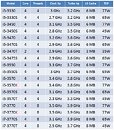Monday, November 28th 2011

Intel Ivy Bridge Desktop Processor Models Tabled
Russian website Overclockers.ru claims to have a complete picture of what Intel's upcoming 22 nm Core "Ivy Bridge" desktop (2012 Core Processor Family) looks like. The site compiled model names, extensions, clock speeds, Turbo Boost speeds, L3 cache sizes, and TDP ratings of as many as 18 models, most of which are quad-core.
The table reflects that most clock speeds are similar to today's Sandy Bridge LGA1155 processor models, some have Turbo Boost speeds as high as 3.90 GHz. Since Ivy Bridge silicon is an optical shrink of Sandy Bridge LGA1155, from 32 nm to 22 nm, and since Intel is using a more energy-efficient transistor design, there are significant improvements in TDP ratings.
Source:
Overclockers.ru
The table reflects that most clock speeds are similar to today's Sandy Bridge LGA1155 processor models, some have Turbo Boost speeds as high as 3.90 GHz. Since Ivy Bridge silicon is an optical shrink of Sandy Bridge LGA1155, from 32 nm to 22 nm, and since Intel is using a more energy-efficient transistor design, there are significant improvements in TDP ratings.

57 Comments on Intel Ivy Bridge Desktop Processor Models Tabled
mommeeeee :cry:
i guess its time to give up on AMD :D
1) At 22nm 4c IB is probably the same size as 2c SB at 32 nm.
2) They only have to create one flavor, which saves costs on design, manufacturing, QA... arguably making a second flavor of IB would cost them MORE than selling quads "cheap".
3) Being 4 cores, they can probably increase the street price a bit when compared to 2c SB's. i.e instead of a $120 dual core, they'd sell a $130 quad core, which looks like a lot better for customers, specially when that means chosing between a $500 dual core or $510 quad core Dell/HP/etc build. And because of 1) and 2) Intel just made $10 more per chip sold, because making them costs exactly the same. And considering the cost is probably in the $20-30 range...
They will still sell dual cores, but most certainly under the Pentium brand or something. Also remember that their goal in the not so distant future (2013-2014) is to use SoCs (Atom or nextgen), for those low end builds.
I think that in 2012 and beyond they need to give people incentives to upgrade to a new PC. It's been long since people are using dual core boxes and there's no reason to upgrade for most of them. Changing a ~3.0 Ghz dual core for another 3.something Ghz one is something nobody would really do. On a per core/thread basis SB/IB are not much faster than a Core2 on everyday tasks and it definately isn't on average joe's opinion, for him a 3 Ghz dual core is a 3ghz dual core and that's it. A quad solves that problem by being a "notorious" upgrade in this people's eyes (on top of being a real upgrade).
Also Intel needs to set the bar high for desktops/laptops, so that when ARM enters the market, they find it much harder to do so. Many people believe that ARM cannot touch Intel, but they certainly can IMO, at least if dual cores is what they need to fight. Making the low end quad core solves this problem, at a very small price: they don't have real competition on this generation so they can take this "risk" (smaller gross margin, depending on higher revenues) and like I said they had to eventually make the jump, so why not now.
Of course it's only my opinion, and I don't even know if they will release dual core IB or not, but I'm just saying what I think that more sense to them right now. BTW I think it sucks that they can do whatever they want due to no competition*, but on the other hand don't you think that if AMD was more competitive, maybe quads would have become commonplace a lot sooner? I do think so.
* It's like Red Bull F1 racing team, they can afford to set up their car for very short gears, because they know no one will be able to get close enough in curves so as to overtake them in the strainght line, and in fact going with short gear ratios only makes them have an even bigger advantage.